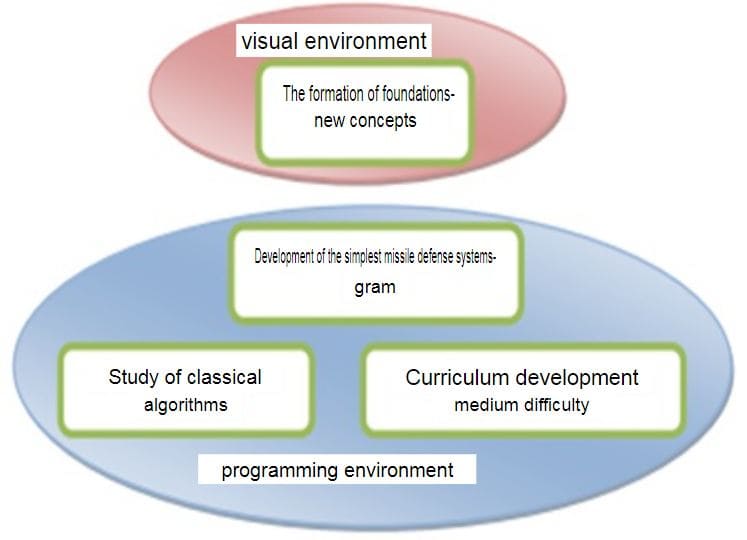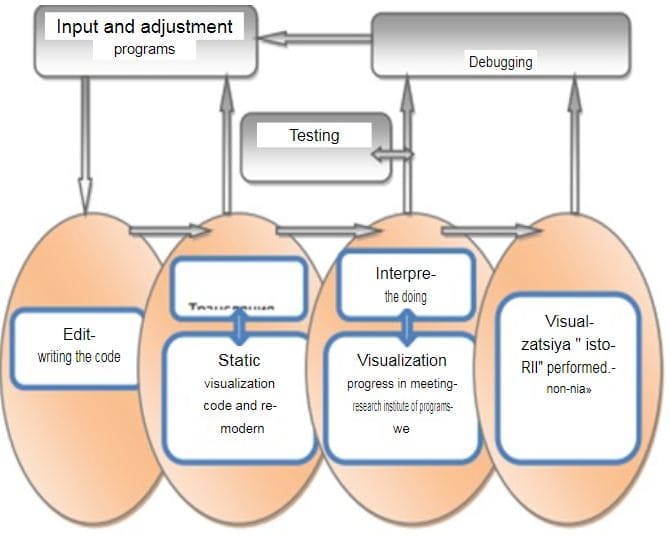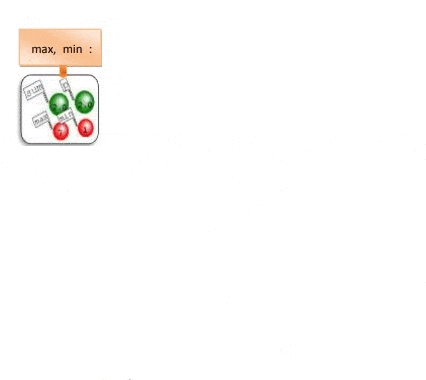Abstract
Content
- Introduction
- 1. Statement of the problem
- 2. Description of educational software
- 2.1 Composition of educational software
- 2.2 Feasibility of using computers in teaching staff
- 3. Technologies for creating computer training programs
- 4. Programming learning model
- 5. Environment for visual learning programming
- Conclusion
- References
Introduction
The current stage of development of society is characterized by a rapid increase in the volume of highly intelligent technologies required for a person capable of active creative mastery of knowledge and the ability to apply this knowledge in non–standard situations. In the context of the development of highly intelligent technologies and their introduction into the learning process, the issues of adapting educational material for its clarity, interpretation and clarity become relevant. The use of well–developed teaching staff in the educational process provides a number of new opportunities and advantages for both the teacher and the student in comparison with the traditional way of teaching. The use of teaching staff makes it possible to implement the principle of individualization of training, to increase the intensity of educational activities, the activity of students. As part of this research work, it is necessary to review and analyze the widely used pedagogical software and types of training programs, as well as determine the main approaches to the creation of e–learning systems. Visualization is the folding of mental contents into a visual image; being perceived, the image can be deployed and serve as a support for adequate mental and practical actions.
1. Statement of the problem
The introduction of information and telecommunication technologies in education in most disciplines gives rise to a complex of problems associated with the development of appropriate software and the content of electronic resources used in education. Research over the past few years has formed the basis for the theory behind the development and application of such learning tools [1].
The purpose of this research work is to develop a model for visualizing educational information in the field of information systems and technologies based on the theory and practice of using didactic tools.
In the process of work it is necessary:
- consider technologies for creating computer training programs;
- analyze the problems of data visualization in training in the field of information systems and technologies;
- to develop a model for visualization of educational material in the field of information systems and technologies;
- during the experimental search work to check: the activity of using the visualization of educational material; the performance of the elements of the model of visualization of educational information and the model itself.
2. Description of educational software
2.1 Composition of educational software
Pedagogical software tool (PPS) is a new didactic tool designed for partial or complete automation of the learning process using computer technology. Educational software tools are not only cost–effective, but also more understandable for today's youth [2].
The pedagogical software includes:
- a program (set of programs) for a computer, aimed at achieving the specified didactic goals in teaching a particular academic discipline;
- a set of technical and methodological documentation on the use of this program in the educational process;
- a set of aids for use in the educational process (tutorials, slides, etc.).
The computer program included in the teaching staff is often called a training program, although it can implement various types of educational activities: the issuance of new educational material, control of the assimilation of knowledge, consolidation of acquired knowledge, etc.
Technical documentation contains a description of the internal structure of the training program, knowledge of which is necessary, for example, when making any changes to the program; instructions for its operation; information about the required composition of technical means, etc.
The methodological documentation contains recommendations for the teacher on the use of the training program and aids in the educational process.
The educational process using a computer is an imitation of educational activity, in which one or another part of the teacher's functions is transferred to the computer: the issuance of educational information, instructions, tasks, control of knowledge and skills, etc. The student's communication with the computer occurs through a dialogue with the content inherent in the teaching staff... The management of the student's cognitive activity as a whole is assigned to the training program, although in some cases the opportunity to choose the path of learning may be given. The training program implements the teaching methodology that was laid down when it was created.
One of the most significant features of the design of training programs is that the basis of such programs is made up of scenarios that include the rules of transition from one situation to another, depending on the actions of the student.
2.2 Feasibility of using computers in teaching staff
It is most advisable to use a computer in cases when it is required:
- individualize training in connection with the large differences in the level of preparedness of students and the strong dependence of learning outcomes on the psycho–physiological and intellectual characteristics of the students;
- perform numerous and monotonous exercises and carry out operational control of the correctness of their implementation;
- to test knowledge on a significant amount of educational material (i.e. to conduct control and test classes) with the provision of assignments that are different in content and order;
- to demonstrate some objects, phenomena, processes, operation of various parts and mechanisms, schemes, etc.;
- to train various mental skills, as well as professional skills;
- perform tasks with a lot of routine calculations or constructions with a wide variety of initial and control data;
- implement non–traditional teaching methods;
- conduct business games of various kinds, as well as apply elements of the game for learning;
- organize guided and supervised independent learning activities;
- ensure repetition and generalization of the knowledge gained, applying it;
- consult, issue various kinds of certificates;
- test trainees;
- collect statistical information on the course of the educational process and process it.
The use of a computer is undesirable when:
- it is necessary to display a significant amount of text material;
- educational material is poorly structured and it is difficult to distinguish logical relationships in it;
- it is required to provide objects, mechanisms, circuits, processes that cannot be entirely accommodated on the monitor screen, and their fragmentation leads to a deterioration in the perception of the studied material;
- the educational process is conducted on such material objects with which the professional activity of the student will be associated, in this case the computer should not replace the real object.
The use of a computer may not give tangible advantages if the educational process is provided with other teaching aids (technical teaching aids, models, simulators, visual aids, etc.) [3].
Currently, a large number of training programs are used in the educational process, which are very different in various parameters. The following types of training programs are usually distinguished:
- to consolidate skills and abilities;
- so–called mentoring programs;
- programs for modeling various situations;
- programs using game techniques and methods;
- programs that implement problem learning.
A computer can perform only some teaching functions (for example, to present material, consolidate skills and abilities) or provide a fragment of learning as a whole (i.e., presentation of new material, setting educational tasks, managing the problem solving process, monitoring and evaluating student activities).
The size
of a fragment (lesson, topic, section, training course) is of fundamental importance, since the methods of developing a script for a lesson and a course of study in a subject are very different: the training program of a training course is not a mechanical combination of many scripts of individual lessons, but a qualitatively different education. This is due to the fact that new problems of the individualization of teaching and the construction of reflexive control appear here.
As for the way of implementing training functions, here the following is of fundamental importance:
- features of interaction between the student and the computer:
а) the presence of a dialogue and its types;
b) the possibility of setting an educational task for students at their own discretion;
- way of managing educational activities:
a) management by response or by process;
b) the level of individualization of teaching (adaptive according to several answers of students or reflexive control based on the construction of a dynamic model of a student);
c) control: direct–indirect (the second type of control assumes that in case of difficulty, the student is offered either an auxiliary task or some heuristic recommendation);
d) the rigidity of determination of management, which sets the "field of independence" of students.
One of the most significant features of the design of training programs is that the basis of such programs is made up of scenarios that include the rules of transition from one situation to another, depending on the actions of the student.
3. Technologies for creating computer training programs
An educational program is a software tool designed to transfer knowledge to students and form the skills and abilities they have in a certain discipline. Educational programs can be roughly divided into: educational games, learning environments and training programs. The development of new information and computer technologies changes the nature and ways of acquiring and disseminating knowledge. Learning technologies are traditionally used in the education system as a means of information transfer and learning. The most effective form of e–learning is a computer–based training program. It allows the student to actively learn and to a large extent compensate for the lack of communication with the teacher [4]. A computer training program as an e–learning software tool can be represented as a system consisting of two subsystems:
- informational (content);
- software (software implementation).
4. Programming learning model
Primary learning tasks should be associated, first of all, with the development of logical, algorithmic thinking. Many new concepts need to be formed, such as variables and data types. It is necessary to teach how to "invent" an algorithm and describe it by means of control structures (selection, loop, branching). Knowledge of the basics of data representation and classical algorithms is required. Simply learning the syntax and semantics of a particular language is not enough. One of the successful technologies for the formation of algorithmic thinking is the use of visual gaming environments at the initial stage of learning, such as LOGO, Aliсe, Squeak, Sсratсh. In these environments, the learner does not work with abstract representations, but with some visual images that form the concepts of the programming model to which they are oriented. Then, in accordance with the paradigm supported by the visual environment, a certain initial programming language is chosen, in which the simplest algorithms are developed, data structures and classical algorithms are studied [7].
An important factor is the choice of a programming environment in which the main stages of program development (coding, debugging, testing) are performed. The sequence of the implementation of the training stages is shown in Figure 1. At the first stage, visual visual images are used, and at all the rest, the student operates in terms of abstract concepts: data types, structures, objects or function calls, depending on the programming paradigm. Moreover, these abstract concepts do not in any way correlate with the visual images of the first stage, since they are implemented by various software systems: the visual environment and the programming environment.
In addition, after fermentation, a disinfected substance remains – an organic, odorless substance that can serve as an organic fertilizer. Waste processing technology using methanobacteria can save up to 40% of electricity and natural gas in rural areas.

Figure 4.1 — Stages of the programming learning process
With their help, it is possible to organize training so that the study of programmer abstractions is not an end in itself, but would be a "side effect" of achieving a meaningful goal: modeling a physical process, creating a computer game, etc. However, in modern conditions it is impossible to limit ourselves only to studying a specific language and programming environment... It is necessary to study the concepts of various programming paradigms (imperative, object–oriented, functional), mastering classical algorithms and programming technologies.
5. Environment for visual learning programming
In our opinion, for the successful formation of algorithmic thinking and the basic concepts and techniques of programming, a certain visual programming learning environment (SVOP) is needed, which will combine the technologies used both in visual systems and in integrated programming environments, and extend them to the learning process... Such a system will allow the student to correlate abstract data structures, objects, programming constructs with some associative visual images created simultaneously with the writing of the program. Moreover, the visualization technology in the environment must be implemented for all standard stages of program development.

Figure 5.1 — Organization of work in SVOP
The organization of the user's work in SVOP is shown in Figure 2. The proposed approach can be used for any programming paradigm and any language of primary education.
At present, an experimental version of the environment is being developed, in which the structured programming model is being implemented, as it most fully meets the tasks of primary education, and the Pascal language is used as an algorithmic language, which is widely used for teaching both in secondary schools and in junior courses of higher educational institutions.
5.1 Imaging technology
The visualization technology used in the system is based on the idea of ?correlating the program entities and visual objects, that is, on the visualization metaphor. Metaphor is a description, in particular a certain geometric image that forms the concept of a new object or phenomenon through the establishment of similarity with an already known one. And when choosing it, the following aspects must be taken into account:
- syntactic and semantic notation of the language;
- pragmatics of language;
- teaching component, that is, what concept or programming skill should be formed as a result of the application of the metaphor.
For SWAP, the formation of a metaphor was carried out according to the scheme:
- selection of the visualized aspect of the program;
- choice of a graphic model;
- choice of correspondence between the program and the graphics, which simultaneously determines the behavior of the graphic model;
- defining a set of actions for user interaction with a graphical model.
Let's consider the process of choosing a metaphor using the example of the concept of "variable" in imperative programming (Table 1). Syntax and semantics. Each variable has a name and type, simple or structured. A variable of a simple type stores only one value of a specific type. A variable of a structured type (array, record, etc.) has a name, consists of several elements of possibly different types, each of which can be accessed, for example, by its index to an array element. Pragmatics. A variable of a simple type can either "take" a value if it is on the left side of the assignment operator, or "give" its value if it is included in an expression. When a new value is received, the old value of the variable is not saved; when passed, the variable retains its value.
Learning component. A variable is a memory area, the address (name) of which can be used to access the data (value) stored in this area [6].
Table 1 — Choice of the "variable" metaphor

In SWOP, metaphors for variables, expressions, basic constructions, functions and their calls are developed and implemented. After a successful broadcast, the system displays the program text and its graphic model. It is allowed to move graphic objects, control the visualization process, etc. When interpreting the program (at the user's request), you can view in an animated form the sequence of statements execution, the process of changing the values ?of variables, a metaphor for the execution of each programming construct. In addition to supporting the learning process, these capabilities can be used as a means of visual debugging of the program.

Figure 5.2 — Metaphors for representing variables
(анимация: 5 кадров, 6 циклов повторения, 122 килобайт)
Conclusion
Thus, the use of a visual environment for teaching programming allows the use of visualization technology at all stages of program development. The environment provides the user with the opportunity to view the graphic image of all its components when entering the program, which contributes to the formation of basic programming concepts. Then, during interpretation, the student observes the animation of the graphic image, learning the semantics. Currently, the possibility of using this approach for teaching object–oriented programming and the pragmatics of executing each structure and program as a whole is being considered.
References
- Аязбаев, Т. Л. Технология создания компьютерных обучающих программ / Т. Л. Аязбаев, Т. А. Галагузова // Международный журнал экспериментального образования. – 2015. – № 3–1. – С. 76–78.
- Авербух В. Л. К теории компьютерной визуализации. // Вычислительные технологии Т. 10, № 4, 2005.– С. 21–51.
- Дубенский, В. В. Технология создания электронных обучающих систем / В. В. Дубенский [Электронный ресурс]. – Режим доступа: http://tekhnosfera.com/tehnologiy...
- Олифер, В. Новые технологии в обучении / В. Олифер, Н. Олифер – СПб.: БХВ–Санкт–Петербург, 2000. – С. 124–140.
- Ананьева Т. Н., Черткова Е. А. Методология разработки компьютерных обучающих систем для сферы образовательных услуг // Теоретические и прикладные проблемы сервиса. 2007. № 2. С. 48–51.
- Федоров А. Компьютер–учитель // Компьютер–пресс. М., 1996. № 4.
- Флойд Р. Парадигмы программирования. // Лекции лауреатов премии Тьюринга за первые двадцать лет 1966–1985. – М.: Мир, 1993. – С. 86–98.
